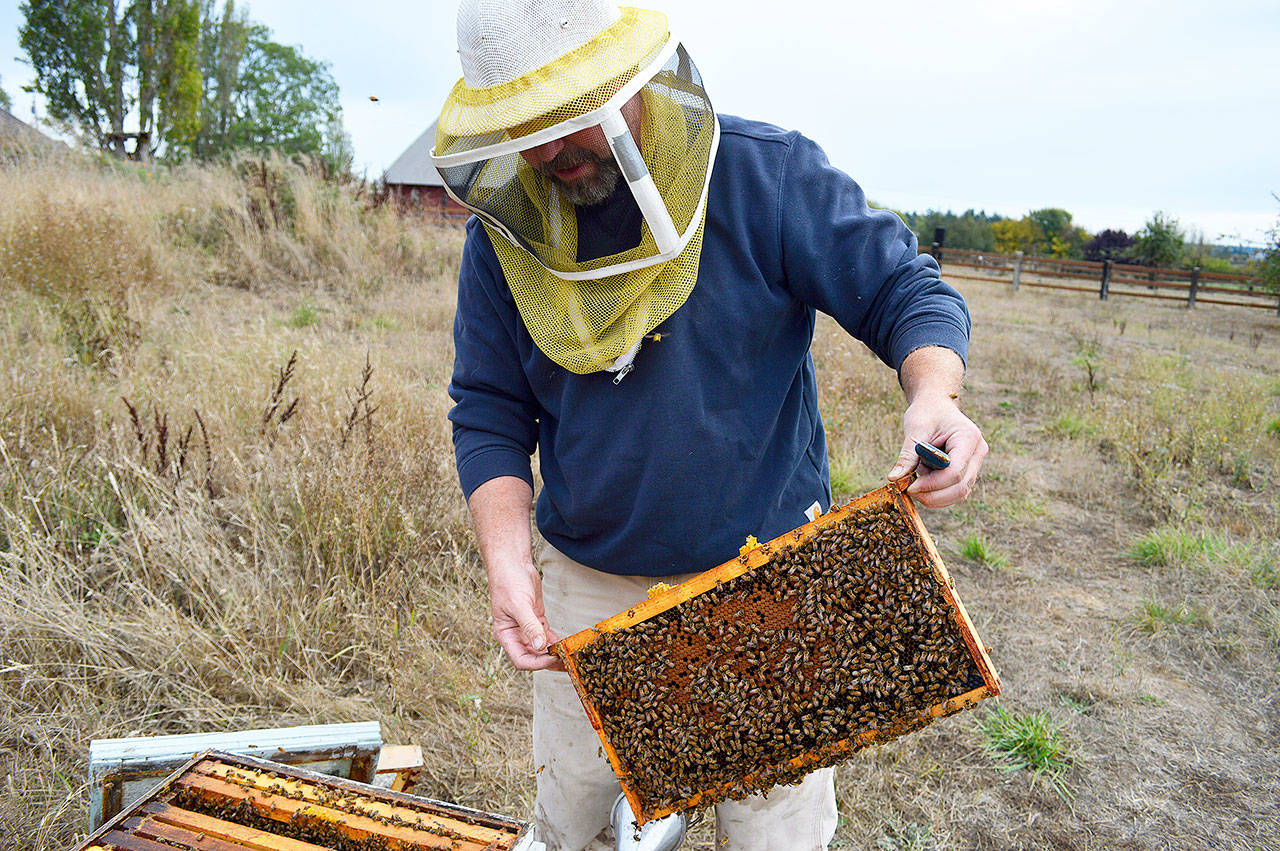Honey, it was a great summer for bees on Whidbee.
Or was it?
Opinions range from very good to nothing to buzz about among local beehive keepers about the 2017 summer honey season.
Timothy Lawrence, county director and associate professor at Washington State University Extension Office, says the school’s 100 bee colonies produced lots of the sweet sticky stuff.
“We produced over 3,000 pounds of honey this year — and easily left that much on the bees — so it was a very good honey year,” Lawrence said.
“We really don’t try and make honey. Our focus is on bee breeding and stock improvement,” he said of WSU Honey Bee Health program. “But when the honey comes we need to deal with it.”
WSU places hives from Clinton to north of Oak Harbor and also has a few at its Mount Vernon research center.
“If you did not produce honey this year you should find a new hobby or profession,” Lawrence said.
Bruce Eckholm of Eckholm Farm in central Whidbey says his hives produced 1,000 pounds of honey.
“I would say honey harvest this year was decent,” said Eckholm, a bee biologist who periodically gives tours of his apiary. “It’s way better than last year but not nearly as good as the year before.”
Robert Niles of Shady Lane Bees, east of Oak Harbor, calls it a “medium” year.
Of his six hives placed from Admiralty Inlet to Deception Pass, 140 pounds of honey were produced this summer. In 2015, which he deemed “a really good year” six hives produced 240 pounds.
He considers his honey more of a hobby than a business.
“Oh, I just love playing with the guys,” he said, after returning from a visit to one of his hives.
The flavor of honey changes depending on where the bees pollinate, he said.
Since Himalayan blackberries, which Niles described as “the one everyone hates and wants to get rid of” grow throughout Whidbey, that’s a flavor found in many Whidbey-grown honey jars.
“The bees fixate on whatever is prevalent,” Niles explained.
He also has hives set up on West Beach Road. “So they pick up a wildflower crop like strawberry and rose, maybe some clover mixes in.
“I love these different areas on the island.”
Honey on Whidbey Island generally peaks four to six weeks after the big blackberry bloom, Niles said.
Whidbey Island Beekeepers Association, aka Whidbees, has about 50 members that meet monthly in Freeland. The majority have one or two bee hives.
Location and weather make a big difference in both the taste and crop of honey.
“With Whidbey’s micro-climates and range of nectar and pollen sources, honey production varies from place to place on the Island,” said Todd Peterson, president of Whidbees. “For this reason, honeybees, with their foraging, provide a window on the plants and climate where you live.
“With the cold and very wet spring, my colonies on the South end were slow to build up. But the warm, sunny weather that followed enabled an above-average honey crop.”
Honey production may have varied but not reports about yellow jackets.
Many described “tons” of marauding yellow jackets attacking colonies, trying to overwhelm the hive’s entrance guards.
“They swarm the hives and inevitably yellow jackets sneak in,” Niles explained. “They’re desperate to go in and get a little taste of honey.”
And they sting. Unlike his buddy bees.
“Out of 60,000 bees, none of them stung me,” Niles said recently after checking a hive. “But a yellow jacket did.”
Some beekeepers experienced loss of hives to mites.
“We lose about 50 percent of our hives each year,” Niles explained. The main culprit is the blood-sucking Varroa Mite, parasites that attack both honey bees and their brood.
Hunter’s Moon Farm, known for its organically-grown blueberries, lost two hives.
It partners with Belleville Honey in Burlington, which provides a pollination service and harvests the honey grown on Hunter’s Moon Farm north of Oak Harbor.
A honey of a year happened at Pacific Rim Institute, which harvested the hives of the WSU Honey Bee Health program.
“We had a bumper crop, so to speak,” said director Robert Pelant. “It’s been a great year for honey.”
• Sales of the honey produced by WSU bees and extracted and bottled by PRI help support both programs. Three sizes are available: 1.75 oz. for $2.50, 11 oz. for $8, 22 oz. for $15. It’s for sale at WSU Extension office, 406 N. Main St., Coupeville and Pacific Rim Institute, 180 Parker Road., Coupeville.


